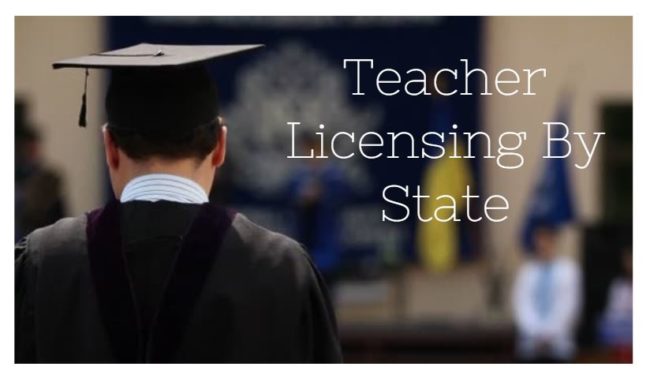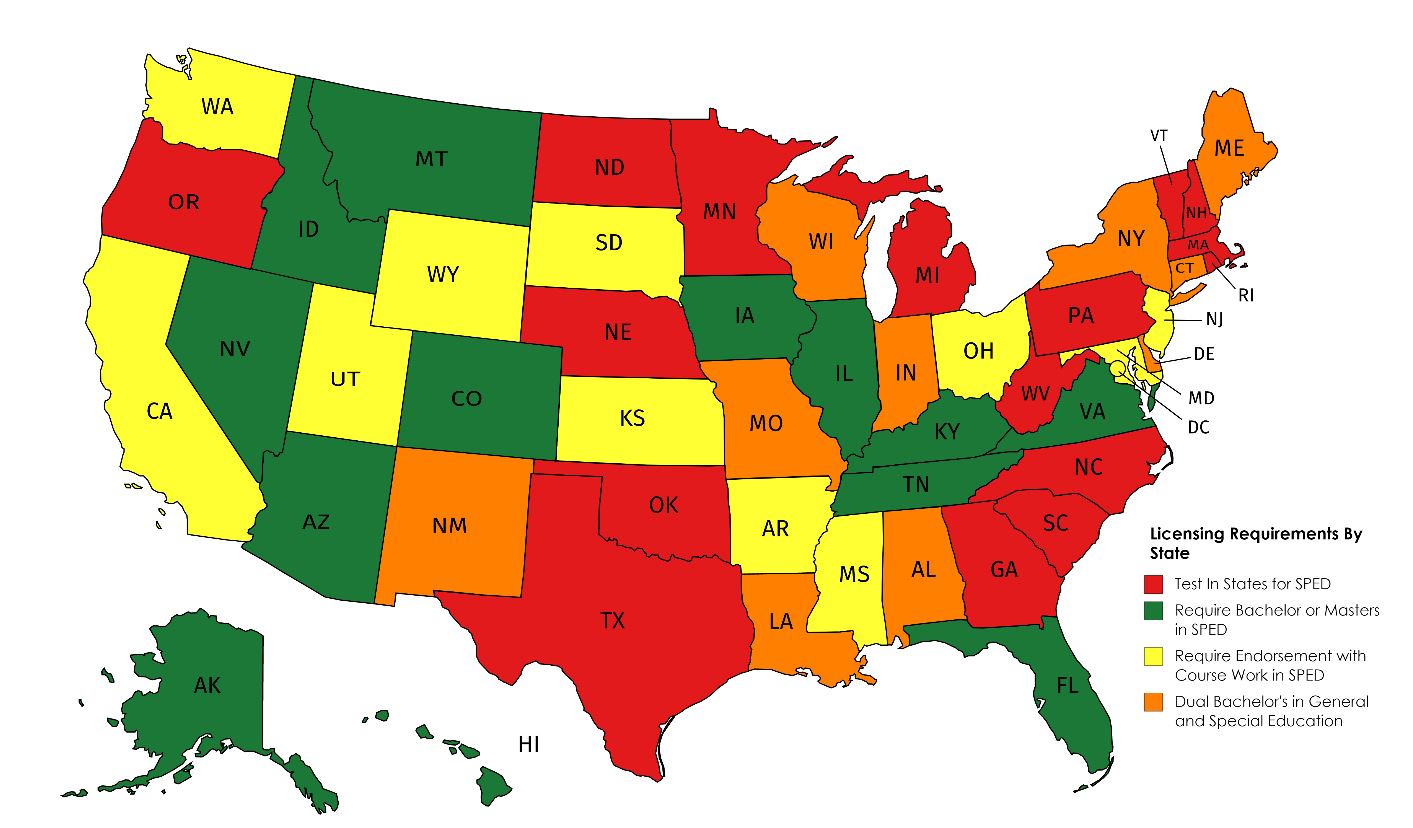Teacher Licensing By State

No two states licensing requirements are created equal. Federal guidelines indicate that each state can set the standard and requirements for teacher licensing. The lack of consistent requirements for teacher licensure means that there is no standard definition for special education teacher qualifications. States require different degrees, course work and testing requirements for a special education teacher to receive licensure. Two of the basic requirements that all states have, is requiring a teacher to hold a bachelor’s degree and pass the state certification test for general education. These certification tests require that a teacher candidate present competency in the content area that they will teach in. This means passing either the elementary, middle or secondary content tests. For middle and secondary teachers, an additional test may be required for the content area they will teach such as math or history. For special education teachers, there are different tests that candidates must pass in order to demonstrate competency in pedagogical skills needed for teaching students with disabilities. Pedagogical knowledge refers to specialized knowledge that teachers possess for creating effective teaching and learning environments for students. Students who are eligible for special education services require an individual education plan. Pedagogical knowledge is required for teachers who teach students with disabilities. These skills include learning strategies, explicit teaching skills, being able to individualized based on student data and measuring student performance.
Each states decides the requirements for special education teachers to gain licensure. Below is a map of requirements by state for special education teachers and their descriptions.

Descriptions of Special Education Teacher Licensing by State
| Test In State: | Test in states only require candidates to have taken and passed one course on exceptional children. This course can be done either through a traditional teacher preparation program or through completion of requirement of the states alternative routes to teacher licensure. |
| Require Endorsement with Coursework | States that require an endorsement with coursework for teachers to obtain special education licensure require candidates to complete a minimum of number of hours on content dedicated to teaching students with disabilities. State require anywhere from 24 - 36 hours of coursework to obtain the endorsement. |
| Dual Enrollment Bachelor's Degree | States that require dual enrollment offers teaching candidates the option to complete the coursework required for general education and special education in a combines bachelors degree. These requirement for hours in special education vary depending on the college or university. |
| Bachelors or Masters Degree Required | These states require teaching candidates to have successfully completed a bachelors or masters degree in special education. Colleges and universities design undergraduate or graduate programs around content and pedagogical skills needed to teach students with disabilities. These schools usually differentiate between a high or low incidence track so candidates take course with pertaining to the student population they are going to work with. |
References:
Alabama State Department of Education. (2019). Retrieved October 1, 2019, from https://www.alsde.edu/.
Alaska Department of Education & Early Development. (2019). Retrieved October 1, 2019, from https://education.alaska.gov/.
Arkansas Department of Elementary and Secondary Education. (2014). Retrieved October 1, 2019, from http://dese.ade.arkansas.gov/.
Arizona Department of Education. (2019). Retrieved October 1, 2019, from https://www.azed.gov/.
Boe, E. E., & Cook, L. H. (2006). The chronic and increasing shortage of fully-certified teachers in special and general education. Exceptional Children, 72, 443–460.
California Department of Education. (2019). Retrieved October 1, 2019, from https://www.cde.ca.gov/.
Chapey, G. D., Pyszkowski, I. S., & Trimarco, T. A. (1985). National trends for certification and training of special education teachers. Teacher Education and Special Education, 8(4), 203-208.
Colorado Department of Education . (2019). Retrieved October 1, 2019, from https://www.cde.state.co.us/.
Delaware Department of Education . (2019). Retrieved October 2019, from https://www.doe.k12.de.us/.
Florida Department of Education. (2019). Retrieved from http://www.fldoe.org/.
Georgia Department on Education. (2019). Retrieved October 1, 2019, from https://www.gadoe.org/Pages/Home.aspx.
Hawaii Department of Education. (2019). Retrieved October 1, 2019, from http://www.hawaiipublicschools.org/Pages/Home.aspx.
Idaho State Department of Education. (2019). Retrieved October 1, 2019, from https://www.sde.idaho.gov/.
Illinois State Board of Education. (2019). Retrieved October 1, 2019, from https://www.isbe.net/.
Indiana Department of Education . (2019). Retrieved October 1, 2019, from https://www.doe.in.gov/.
Iowa Department of Education. (2019). Retrieved October 1, 2019, from https://educateiowa.gov/.
Kansas State Department of Education. (2019). Retrieved October 1, 2019, from https://www.ksde.org/.
Kentucky Department of Education. (2017). Retrieved October 1, 2019, from https://education.ky.gov/Pages/default.aspx.
Louisiana Department of Education. (2018). Retrieved January 2019, from https://www.louisianabelieves.com/.
Maine Department of Education. (2019). Retrieved October 1, 2019, from https://www.maine.gov/doe/home.
Maryland State Department of Education. (2019). Retrieved October 1, 2019, from http://marylandpublicschools.org/Pages/default.aspx.
Massachusetts Department of Elementary and Secondary Education. (2019). Retrieved October 1, 2019, from http://www.doe.mass.edu/.
Michigan Department of Education. (2019). Retrieved October 1, 2019, from https://www.michigan.gov/mde.
Minnesota Department of Education. (2019). Retrieved October 1, 2019, from https://education.mn.gov/mde/index.html.
Mississippi Department of Education. (2019). Retrieved October 1, 2019, from https://www.mdek12.org/.
Missouri Department of Elementary and Secondary Education. (2019). Retrieved October 1, 2019, from https://dese.mo.gov/.
Montana Office of Public Instruction. (2018). Retrieved October 1, 2019, from http://opi.mt.gov/.
Nebraska Department of Education. (2019, November 4). Retrieved October 1, 2019, from https://www.education.ne.gov/.
Nevada Department of Education. (2012). Retrieved October 1, 2019, from http://www.doe.nv.gov/.
New Hampshire Department of Education. (2012). Retrieved October 1, 2019, from https://www.education.nh.gov/.
New Jersey Department of Education. (2018). Retrieved October 1, 2019, from https://www.nj.gov/education.
New Mexico Public Education Department. (2019, October 24). Retrieved October 1, 2019, from https://webnew.ped.state.nm.us/.
New York State Education Department . (2019). Retrieved October 1, 2019, from http://www.nysed.gov/.
North Carolina Public Schools. (2018). Retrieved October 1, 2019, from http://www.ncpublicschools.org/.
North Dakota Department of Public Instruction. (2019). Retrieved October 1, 2019, from https://www.nd.gov/dpi/.
Ohio Department of Education. (2019). Retrieved October 1, 2019, from http://education.ohio.gov/.
Oklahoma State Department of Education |. (2019). Retrieved October 1, 2019, from https://sde.ok.gov/.
Oregon Department of Education. (2018). Retrieved October 1, 2019, from https://www.oregon.gov/ode/Pages/default.aspx.
Pennsylvania Department of Education. (2019). Retrieved October 1, 2019, from https://www.education.pa.gov/Pages/default.aspx.
Rhode Island Department of Education. (2019). Retrieved October 1, 2019, from https://www.ride.ri.gov/.
South Carolina Department of Education. (2019). Retrieved October 1, 2019, from https://ed.sc.gov/.
South Dakota Department of Education. (2018). Retrieved October 1, 2019, from https://doe.sd.gov/.
Tennessee Department of Education . (2019). Retrieved October 1, 2019, from https://www.tn.gov/education.html.
Texas Education Agency. (2019). Retrieved October 1, 2019, from https://tea.texas.gov/.
Utah State Board of Education. (2019). Retrieved October 1, 2019, from https://www.schools.utah.gov/.
Vermont Department of Education. (2019). Retrieved October 1, 2019, from https://education.vermont.gov/.
Virginia Department of Education. (2019). Virginia Department of Education. Retrieved October 1, 2019, from http://www.doe.virginia.gov/.
Washington State Board of Education . (2019). Retrieved October 1, 2019, from https://www.sbe.wa.gov/.
West Virginia Department of Education. (2019, September 26). Retrieved October 1, 2019, from https://wvde.us/.
Wisconsin Department of Public Instruction. (2019). Retrieved October 1, 2019, from https://dpi.wi.gov/.
Wyoming Department of Education. (2019). Retrieved October 1, 2019, from https://edu.wyoming.gov/.
Special Education Teacher Certification/ Licensure and Endorsement Categories in the States. (2004). Education Commission of the States. Retrieved September 28, 2019, from https://www.ctc.ca.gov/docs/default-source/educator-prep/special-education-docs/ecs-special-ed-state-note.pdf.
